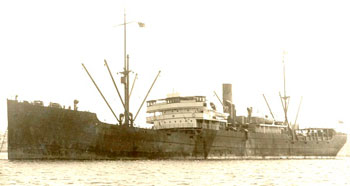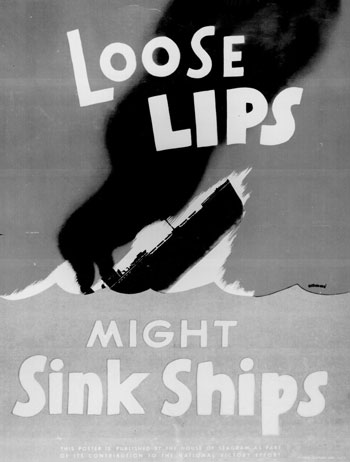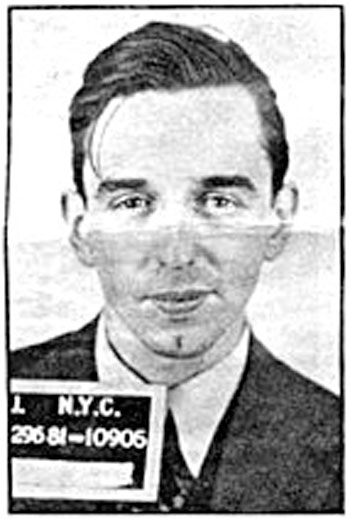Subs & Spies in WWII Maine
by Tom Seymour

The 5,458-ton Canadian steam merchant ship Cornwallis, which was torpedoed and sunk off Mount Desert Rock, Maine by a German submarine on December 3, 1944. The five survivors were picked up by a fishing boat. The same sub dropped off two spies on 11/29/44.
In Midcoast Maine the post-World War II generation was frequently regaled with tales of past intrigue involving German spies and their supposed spy station atop Mt. Percival in Northport.
Mt. Percival, a promontory along the Maine coast, holds a commanding view of upper Penobscot Bay, including the all-important docks just up the coast at Searsport. During the war, the U.S. Army Transportation Corps managed a munitions depot at Mack Point in Searsport and from there, ammunition was shipped to the European theater.
This alone put the entire area under the enemy’s magnifying glass. While little visible evidence remains of this site’s importance during World War II, people who worked there and even youngsters living nearby, captivated by the frantic activity, remembered what went on at Mack Point and the excitement of the times. And those people kept that era alive.
But it was the behind-the-scenes scenario that lingered for generations, the idea that German spies were constantly at work monitoring what passed through the depot at Searsport and sending wireless messages to German submarines lurking just offshore. Was this true, or was it simply born of a union of facts along with supposition? No one can say.
As a teenager, the author, like so many young people, made his way to the summit of Mt. Percival. There, the burnt remains of a structure first met the eye. And in the center of the mass of burnt boards and rusted pipes, was a solid concrete foundation of perhaps 6 feet or more high. Standing atop this foundation, or wall, allowed for a birds-eye view of the Searsport docks.
So it was easy to imagine that here, almost 75 years ago, enemy agents watched, photographed and planned for a strike against the American war effort.
Since the day of the author’s visit more than 50 years ago, the near-impassable dirt road to Mt. Percival has become passable and the whole landscape has changed through development. But the mountain still stands, witness, some say, to great intrigue during the late war.
Operation Magpie
Throughout the war, Germany had done their best to infiltrate America with the intent of sabotage. But in the war’s waning years, their efforts had had very little effect. So it was that Operation Magpie, a last-chance hope of embedding German spies in America begun in 1944 and one of its tentacles reached out to a beach near Bar Harbor, Maine.
A German U-boat, Germany’s submarine of the time, skulked at the bottom of the sea near the entrance to Frenchman Bay, waiting for local boat traffic to cease so that two spies could come ashore and mingle with the Americans.
Back then, strangers were immediately recognized as being from somewhere other than Maine. The two spies, Erich Gimpel and William Colepaugh, were poorly suited to carry out their sham. Both men wore light dress clothing, totally unsuitable for being outside in a Maine winter. And both men carried heavy, money-filled baggage, another potential tipoff. But the German spies had one advantage; William Colepaugh was an American, born in Connecticut, who had defected to Germany with the offer to help win the war for Germany.
Colepaugh had been discharged under unfavorable circumstances from the U.S. Naval resrves in 1943. While a crewman on ship bound for Europe he defected to a German consulate in 1944. He recieved firearms and espioange training at a German spy school. Gimpel was a radio operater at a mining company in Peru when the war began and became a spy for Germany. It was Colepaugh who was to do all the talking, since Gimpel was a German national, spoke little English and wasn’t as versed in Americana as his partner.
Despite the red flags raised by the men’s appearance, they managed to avoid contact with people in the Town of Hancock where they made their way to U.S. Route 1. They hailed a taxi which took them to the railroad station in Bangor, where they booked a ride to Portland. In Portland, the men bought new American clothes, thus allowing them to fit in and not arouse suspicion because of their appearances.
Colepaugh
The following day Gimpel and Colepaugh took a train to Manhattan New York’s Grand Central Station. The two stayed in a hotel and spent the next week looking for an apartment that was not of steel construction so that they could easily transmit their clandestine messages.
Soon, though, their plans began to unravel. The U-boat 1230, that had dropped them off in Maine remained active for 26 days along the east coast. In its patrolling it located the Canadian Freighter Cornwallis. At 10 am on December 3, 1944 the unescorted Cornwallis was torpedoed and sunk 10 miles southwest of Mount Desert Rock off Bar Harbor, Maine. The master, 35 crew members and seven gunners were lost. Five survivors were picked up by the fishing vessel Notre Dame and landed at Rockland, Maine.
This incident prompted an FBI investigation into whether the same sub might have dropped off German operatives on American soil. And so FBI agents visited Hancock, Maine and were fortunate to find two Hancock residences, both of whom had seen the spies as they walked along Route 1 in a snowstorm. The witnesses described to the agents, as best they could, everything about their sightings.
Spies Captured

World War II poster urging confidentiality regarding coastal shipping. German submarines were sinking so many merchant ships along the Atlantic coast of the U.S. that black outs, no night lights along shore, were in effect and conversations regarding shipping restricted. More than 400 merchant ships headed for Europe we’re sunk by subs off U.S. Atlantic coast in 1942.
Although the two German spies managed to remain in New York undetected, the plan went immediately downhill with William Colepaugh got cold feet and absconded with both suitcases full of money and made his way once more to Grand Central Station.
But Gimpel, upon discerning his partner’s treachery, immediately headed to the train station himself and amazingly, was able to claim the two cash-filled suitcases. Now the German spy was alone in enemy territory. But he had enough money to serve any and all needs and might have escaped detection even longer if Colepaugh hadn’t had an encounter with an old friend. Colepaugh admitted to his friend that he had defected to Germany and had come back to America as a spy.
The friend contacted the FBI and recounted what Colepaugh had told him. And soon, both Colepaugh and Gimpel were captured and in February, 1945, were convicted by a military court and sentenced to death. But before they could be hanged, President Franklin D. Roosevelt died and as a result, federal executions were halted for a month. By the month’s end, victory in Europe was secure and war ceased between the United States and Germany.
New president Harry S. Truman commuted the pair’s death sentences and instead gave both men life in prison. Colepaugh served 17 years of his sentence and then removed to somewhere near Philadelphia, Pennsylvania. Gimpel served only 10 years, after which he was deported to Germany. Gimpel visited the United States again in the 1990s as a guest of a gathering of U-boat aficionados.
Gimpel was sent to Alcatraz, was paroled in 1955 and returned home to West Germany. He later would make his home in South America. His autobiographical account of his undercover work, Spy For Germany, was first published in English in 1957, in Great Britain. The book finally appeared in the U.S. under the title Agent 146 (2003).
U-Boat Incidents
The German submarine that dropped off the two spies in Maine and later sank a Canadian Merchant vessel was not the only German U-boat to visit Maine waters.
Fisherman’s Voice editor Mike Crowe wrote, back in 1999, of another U-boat incident near the entrance of Frenchman Bay, this time on July 2, 1944. This time, two fishermen out of Southwest Harbor, Earnest Stanley and Merrill Stanley reported seeing a periscope traveling at about 12 knots only 300 yards from their boat. The periscope soon disappeared in the sea, after which the two men witnessed a “hull 60 to 90 feet long, approximately 20 feet under water, making a straight wake 25-35 feet wide with patches of oil.”
With clear weather and calm seas, the fishermen were enabled to view the wake for a half hour. The men reported their sighting and soon, a K-type, K-14 blimp arrived to investigate. Blimps were used along with surface vessels to hunt U-boats.
The blimp had orders to search an area 7 miles southeast of Great Duck Island, which lies about 18 miles out of Southwest Harbor. There, a surface vessel reported a sound contact. Then at 8:45 one search vessel was recalled to Rockland and the last contact with the blimp came at 9:20 p.m. Later contacts that night proved fruitless but at 4:55 a.m., the navy learned that the K-14 had crashed in 300 feet of water about 25 miles south of Bar Harbor. Several naval vessels were sent on rescue and salvage missions.
Upon locating the wreckage it was learned that two depth charges were missing from the blimp and 15 or 20 holes were found in the bag, just aft of the car. The holes appeared to have been made by bullets. Four of the crew members had managed to escape the submerged car with the deflated bag draped over it. Ensign Levine, USNR, recalled fighting for air and finally locating a life-saving air pocket. Then, seeing a streak of light, the ensign dove toward it. The four crew members clung to the floating tail fins and other debris and afterward a section of bag that remained partially inflated and was floating on the surface. Two other crew members did not survive the crash.
The surviving crew members described the scene, saying the blimp suddenly lost altitude and was unresponsive to attempts to correct its descent. Ensign Sharp said, “I reached up to dim the lights, sat down and saw the indicator at 200 feet. I gave it the throttle and the nose came up a bit. I reached to give it more gas, the first thing I know she was going in. I hollered it was going in.”
Concurring Reports

William Colepaugh’s NYC police mug shot. Colepaugh and another spy were dropped off by U-Boat 1230 at Hancock Point, Frenchmen’s Bay, ME.
The sinking of the K-14 blimp did not go unnoticed. A naval vessel reported hearing two exploding depth charges while on patrol between Schoodic Point and Grand Manan Island. This was about 40 minutes prior to the estimated time of the crash.
Another vessel stationed off Schoodic Point reported that on July 2 at 9:30 p.m. that Warrant Officer W. Meytrott and his three men “distinctly heard what sounded like six pom-pom shots, possibly from a 20-mm gun.” Warrant Officer Meytrott had observed the blimp about a half hour earlier and given its course, would have been in the crash area about the time of the reported gunfire.
Next, two fishermen working out of Southwest Harbor reported seeing flashes to their west, which they described as “very bright flashes at the waterline and two distinct explosions.” Immediately after this the fishermen said they felt their boat rise in the water twice. The fishermen had seen the K-1 blimp prior to the explosions.
Three men at a weather station at Otter Cliff reported hearing gunfire from the crash area along with an explosion that shook the weather station. And residents of Winter Harbor, Prospect Harbor and Corea heard explosions around 10:30 p.m. These were reported as “heavy, sounded like depth charges and shook their houses.”
Despite this wealth of anecdotal evidence the Northern Group Reports (War Diary) failed to conclude that a U-boat was in the area and that the K-14 blimp was shot down by a U-boat. The missing depth charges from the blimp were never accounted for and it is speculated that they were dropped as a safety measure just prior to the crash.
However, the gunfire reported by so many different individuals clearly suggests U-boat activity. All the same, the government was not able to definitely say a U-boat engagement had taken place. Some sightings were never investigated and the idea that a U-boat was responsible for firing upon and downing the blimp continues unabated. It’s an unsolved mystery that to many people in Hancock County, Maine, is no mystery at all. For them, a German submarine had in fact shot down a blimp in Maine waters.
During the war U-boat sightings were relatively common in Maine’s territorial waters and now, so many years later, these sightings and incidents have become firmly entrenched in the history of Maine’s part in World War II.
